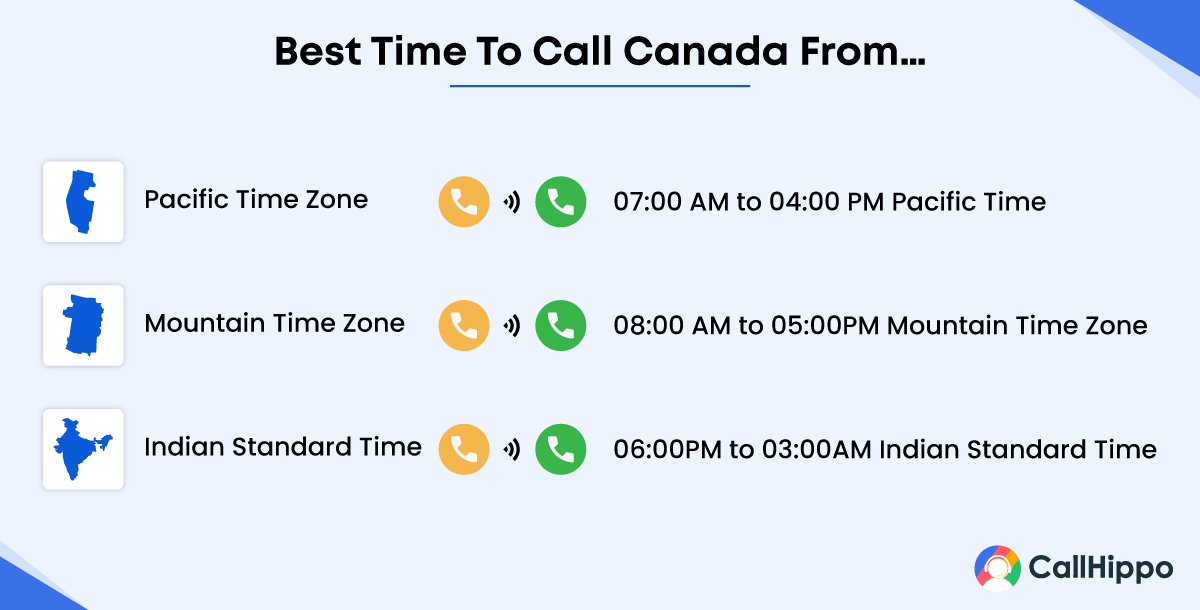Canada, the second-largest country in the world by landmass, spans six time zones from coast to coast. Its vastness creates a diverse landscape of time differences, making it crucial to understand the best times to make a call to various regions within the country. Let’s delve into Canada’s time zones and determine the optimal times to reach out to different parts of this vast nation.
Different Time Zones of Canada
Before making a call, you need to ensure you’re selecting the right time. Different time zones can also impact connectivity and call pick up rates.
1. Pacific Time Zone (PT)
Covers the westernmost provinces of British Columbia and Yukon.
UTC-8 during standard time and UTC-7 during daylight saving time.
2. Mountain Time Zone (MT)
Encompasses Alberta, some regions of British Columbia, the Northwest Territories, and Nunavut.
UTC-7 during standard time and UTC-6 during daylight saving time.
3. Central Time Zone (CT)
Includes Saskatchewan, Manitoba, parts of Nunavut, and some areas of Ontario and Quebec.
UTC-6 during standard time and UTC-5 during daylight saving time.
4. Eastern Time Zone (ET)
Covers the majority of Ontario, Quebec, most of Nunavut, and parts of Labrador and Manitoba.
UTC-5 during standard time and UTC-4 during daylight saving time.
5. Atlantic Time Zone (AT)
Includes Nova Scotia, New Brunswick, Prince Edward Island, and some parts of Labrador and Quebec.
UTC-4 during standard time and UTC-3 during daylight saving time.
6. Newfoundland Time Zone (NT)
Unique to Newfoundland and Labrador.
UTC-3:30 during standard time and UTC-2:30 during daylight saving time.
What Is the Best Time to Call Canada?
Determining the best time to make a call to Canada largely depends on the specific region within the country and the time zone differences.

Here are some considerations:
Pacific Time Zone (PT)
If you’re calling from a region in a time zone ahead of PT, mornings are generally suitable. For callers from areas behind PT, later afternoon or evening hours might be more appropriate.
Mountain & Central Time Zones (MT & CT)
Similar to PT, callers ahead in time zones might opt for morning hours, while those behind might find late afternoon or evening more convenient.
Eastern & Atlantic Time Zones (ET & AT)
For callers from regions ahead of these time zones, late mornings or early afternoons could be preferable. Callers behind these zones might choose the afternoon or early evening for better chances of reaching someone.
Newfoundland Time Zone (NT)
Due to its unique half-hour difference, calls from regions behind NT might aim for late afternoon or evening, while callers ahead might consider late morning or early afternoon.
You May Also Read: What Is the Best Time to Call UK?
Conclusion
Understanding the time zone differences in Canada is pivotal for effective communication. Considering the geographical spread of time zones, it’s essential to be mindful of the recipient’s location when scheduling calls to ensure convenience and efficiency in reaching out to individuals or businesses across this diverse country.
FAQs
1) Are calls to Canada free?
It depends on your phone plan or service provider. Some plans include international calls to Canada, while others may charge a fee for such calls. Check with your provider for details.
2) How do I call Canada from India?
To call Canada from India, dial the international dialing code (00), followed by Canada’s country code (1), the area code, and the recipient’s Canada phone number.
3) How can I call Canada?
Dial the international dialing code (00) followed by Canada’s country code (1), the area code, and the recipient’s phone number.
4) How can I call Canada for cheap?
Use internet-based calling apps or services that offer low-cost or free international calls to Canada. Consider options like Skype, WhatsApp, Google Voice, or other VoIP (Voice over Internet Protocol) services for cheaper calling rates. Additionally, explore phone plans from various providers that offer competitive rates for international calls to Canada.

Subscribe to our newsletter & never miss our latest news and promotions.









